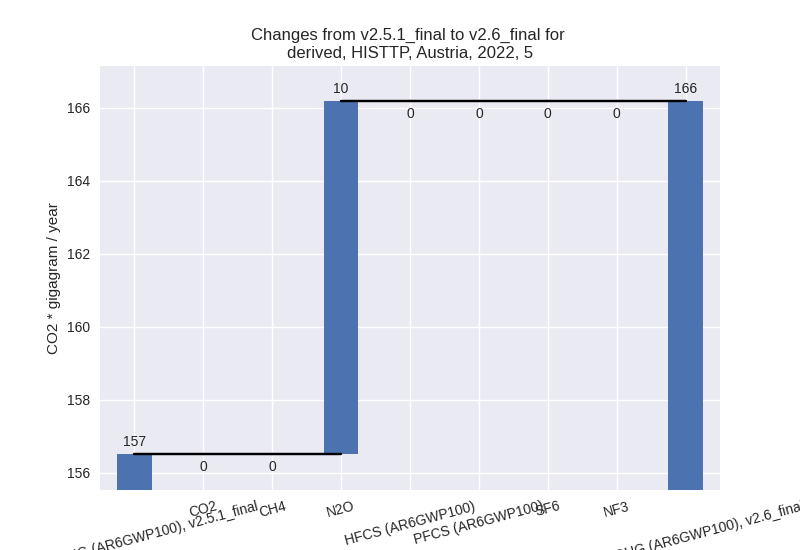Changes in PRIMAP-hist v2.6_final compared to v2.5.1_final for Austria
2024-09-24
Johannes Gütschow
Change analysis for Austria for PRIMAP-hist v2.6_final compared to v2.5.1_final
Overview over emissions by sector and gas
The following figures show the aggregate national total emissions excluding LULUCF AR6GWP100 for the country reported priority scenario. The dotted linesshow the v2.5.1_final data.
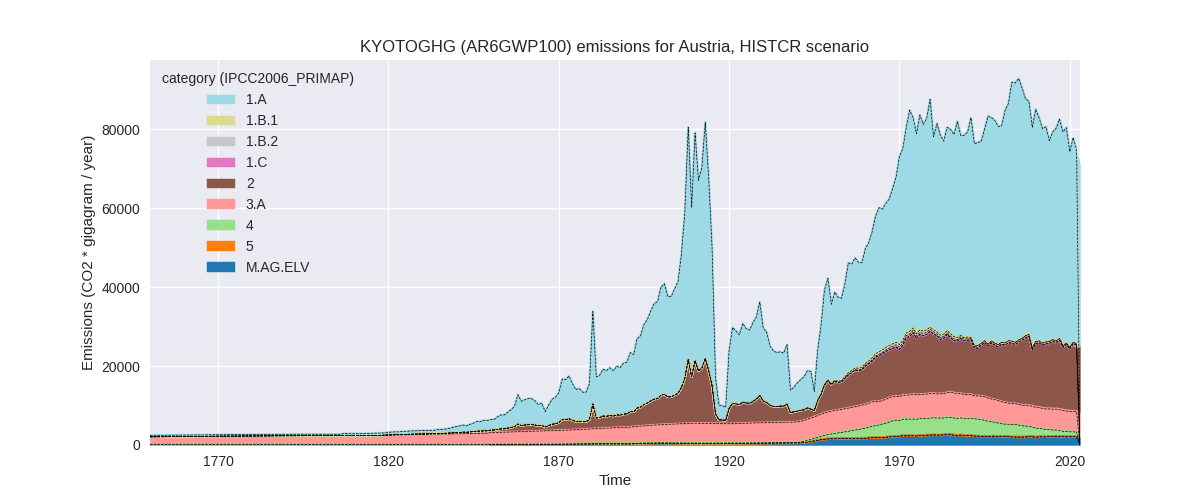
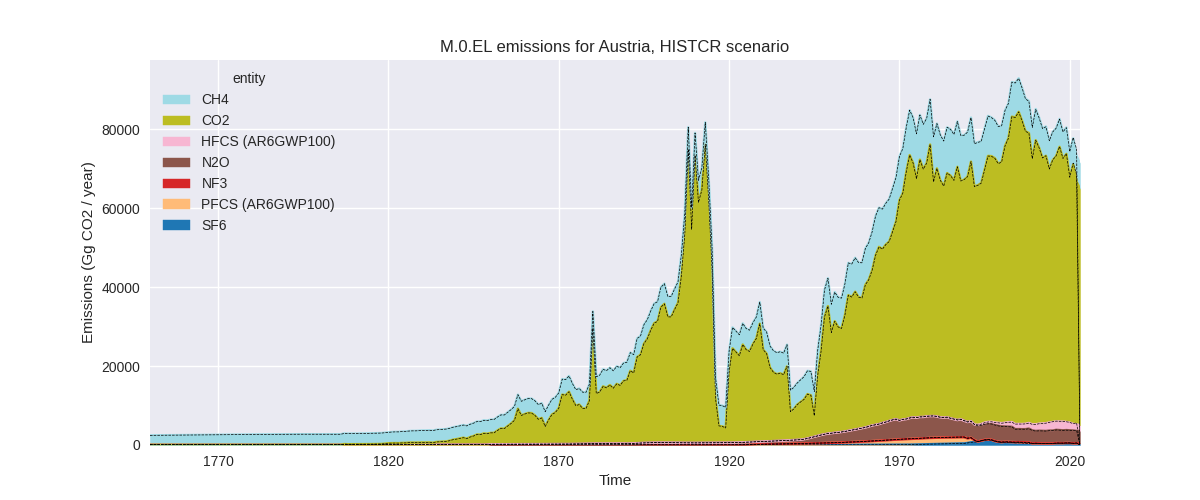
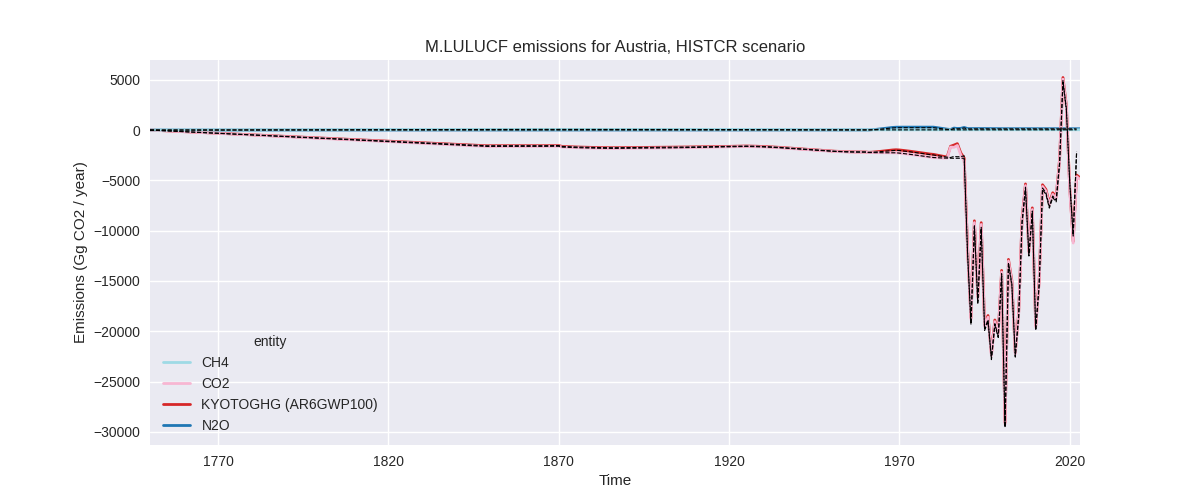
The following figures show the aggregate national total emissions excluding LULUCF AR6GWP100 for the third party priority scenario. The dotted linesshow the v2.5.1_final data.
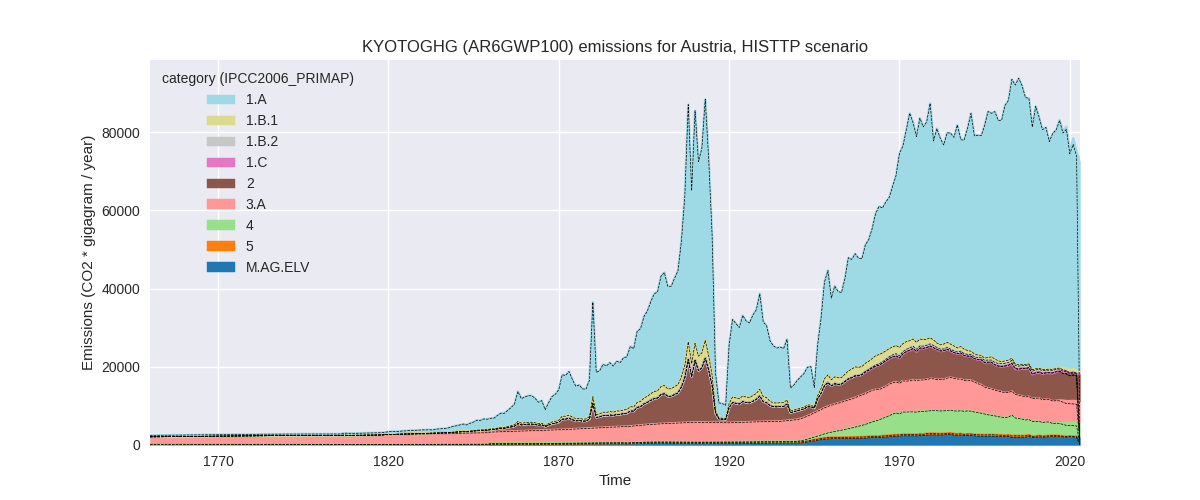
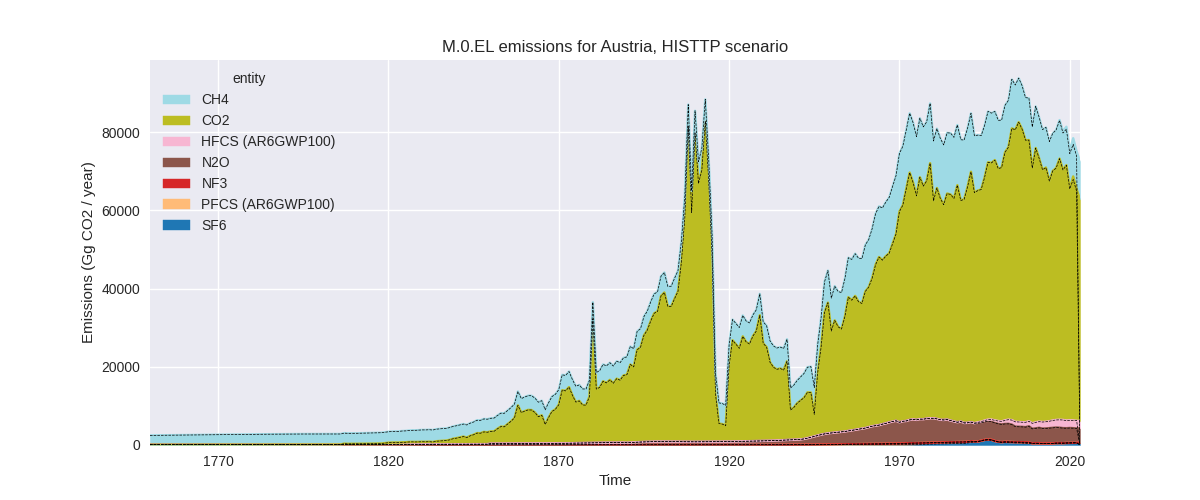
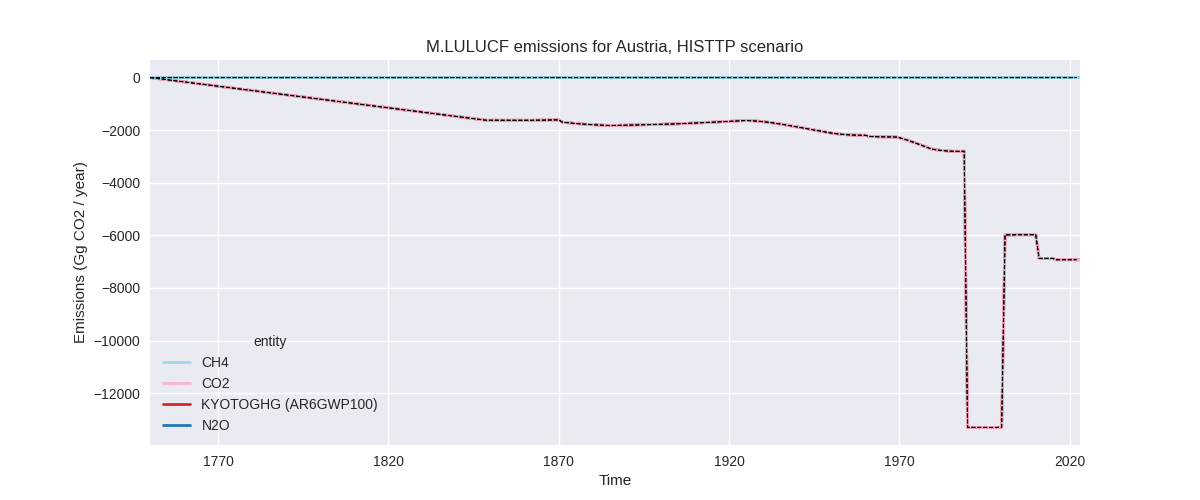
Overview over changes
In the country reported priority scenario we have the following changes for aggregate Kyoto GHG and national total emissions excluding LULUCF (M.0.EL):
- Emissions in 2022 have changed by -2.4%% (-1772.80 Gg CO2 / year)
- Emissions in 1990-2022 have changed by -0.0%% (-5.39 Gg CO2 / year)
In the third party priority scenario we have the following changes for aggregate Kyoto GHG and national total emissions excluding LULUCF (M.0.EL):
- Emissions in 2022 have changed by 1.7%% (1244.01 Gg CO2 / year)
- Emissions in 1990-2022 have changed by 0.1%% (116.35 Gg CO2 / year)
Most important changes per scenario and time frame
In the country reported priority scenario the following sector-gas combinations have the highest absolute impact on national total KyotoGHG (AR6GWP100) emissions in 2022 (top 5):
- 1: 1.A, CO2 with -1154.79 Gg CO2 / year (-2.4%)
- 2: 2, CO2 with -302.30 Gg CO2 / year (-2.1%)
- 3: 2, HFCS (AR6GWP100) with -267.11 Gg CO2 / year (-13.9%)
- 4: 3.A, CH4 with 138.41 Gg CO2 / year (2.9%)
- 5: 2, SF6 with -93.03 Gg CO2 / year (-19.2%)
In the country reported priority scenario the following sector-gas combinations have the highest absolute impact on national total KyotoGHG (AR6GWP100) emissions in 1990-2022 (top 5):
- 1: 1.A, CO2 with -42.17 Gg CO2 / year (-0.1%)
- 2: 3.A, CH4 with 39.12 Gg CO2 / year (0.8%)
- 3: 2, HFCS (AR6GWP100) with -33.28 Gg CO2 / year (-2.6%)
- 4: M.AG.ELV, N2O with 14.40 Gg CO2 / year (0.7%)
- 5: 2, CO2 with -8.08 Gg CO2 / year (-0.1%)
In the third party priority scenario the following sector-gas combinations have the highest absolute impact on national total KyotoGHG (AR6GWP100) emissions in 2022 (top 5):
- 1: 4, CH4 with 765.28 Gg CO2 / year (31.2%)
- 2: 1.A, CO2 with 635.36 Gg CO2 / year (1.2%)
- 3: 2, HFCS (AR6GWP100) with -107.19 Gg CO2 / year (-5.2%)
- 4: 2, CO2 with -57.00 Gg CO2 / year (-1.3%)
- 5: 2, SF6 with -40.35 Gg CO2 / year (-7.4%)
In the third party priority scenario the following sector-gas combinations have the highest absolute impact on national total KyotoGHG (AR6GWP100) emissions in 1990-2022 (top 5):
- 1: 4, CH4 with 50.01 Gg CO2 / year (1.3%)
- 2: 1.A, CO2 with 42.68 Gg CO2 / year (0.1%)
- 3: 5, N2O with 4.91 Gg CO2 / year (1.7%)
- 4: 2, HFCS (AR6GWP100) with -3.25 Gg CO2 / year (-0.3%)
- 5: 4, CO2 with 2.49 Gg CO2 / year (268.1%)
Notes on data changes
Here we list notes explaining important emissions changes for the country. ’' means that the following text only applies to the TP time series, while means that it only applies to the CR scenario. Otherwise the note applies to both scenarios.
- The 2024 EEA data has been included.
- The changes in 2022 estimates in the CR scenario are due to differences of emissions and growth rates in the country reported data to third party datasets and numerical methods used in v2.5.1. This especially pronounces for f-gases where emissions decline after a peak in 2018. The short term decline was not fully picked up by the extrapolation in v2.5.1.
- Changes in the third party scenario are due to the removal of FAOSTAT data for sectors 4 and 5, updated data for energy CO2 and cement CO2 and also the new country reported f-gas data as third party f-gas data does not cover 2022 and later.
Changes by sector and gas
For each scenario and time frame the changes are displayed for all individual sectors and all individual gases. In the sector plot we use aggregate Kyoto GHGs in AR6GWP100. In the gas plot we usenational total emissions without LULUCF. ## country reported scenario
2022
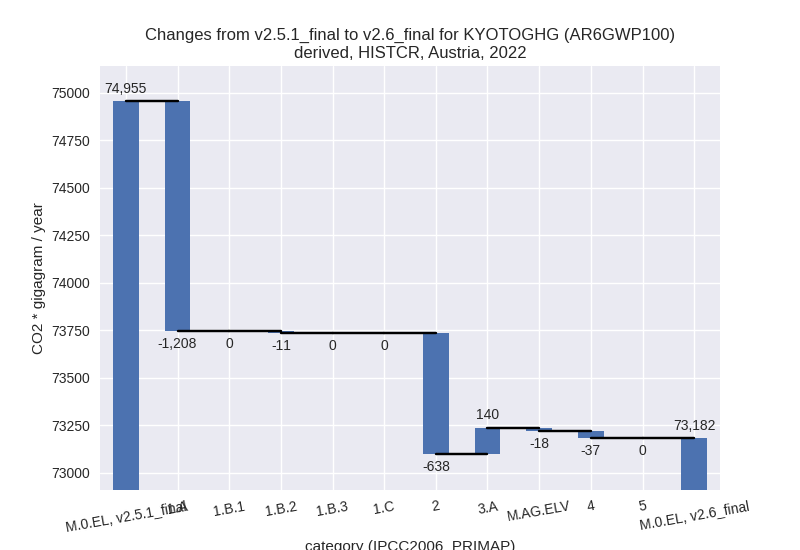
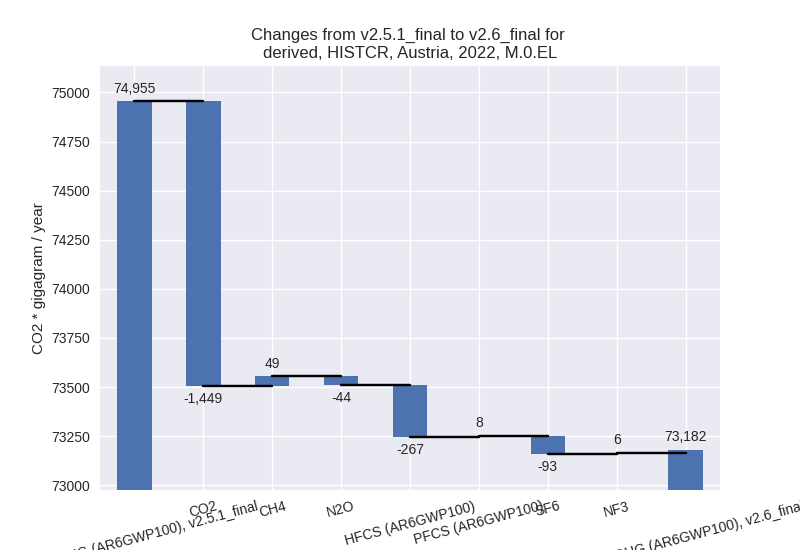
1990-2022
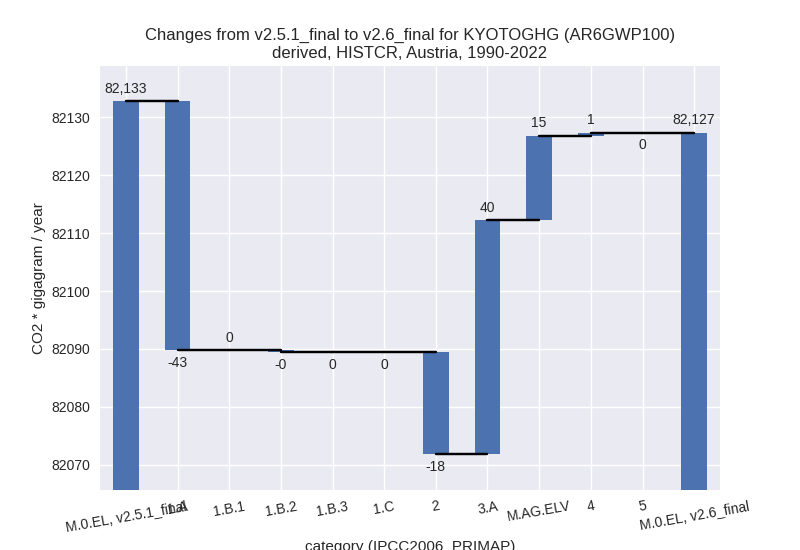
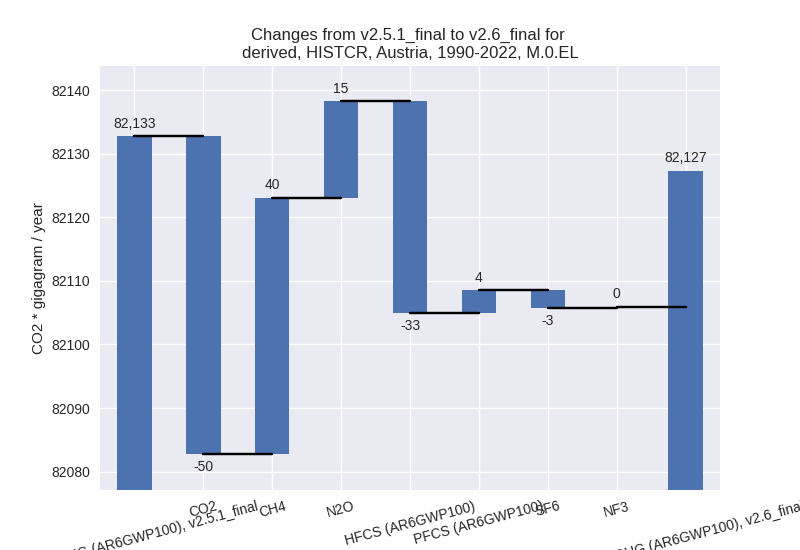
third party scenario
2022
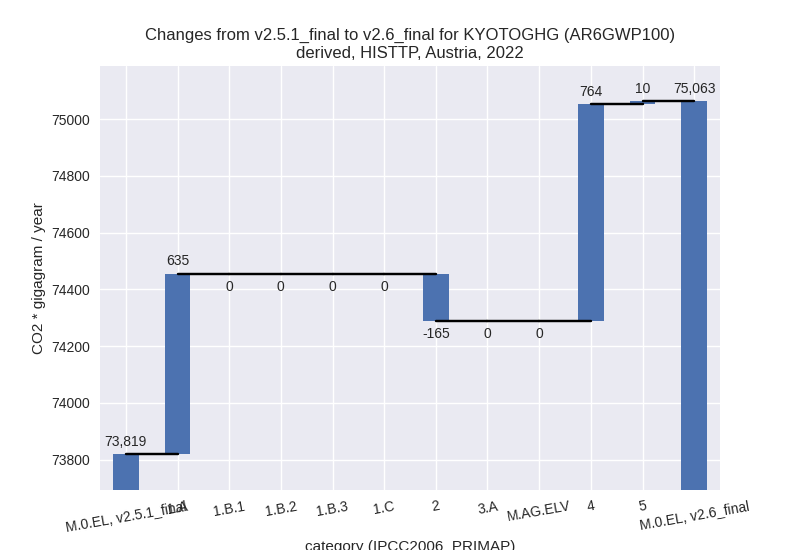

1990-2022
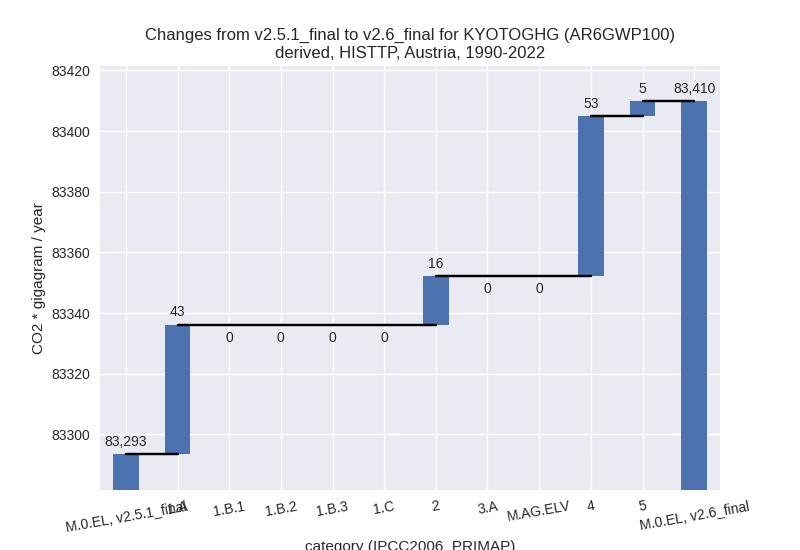
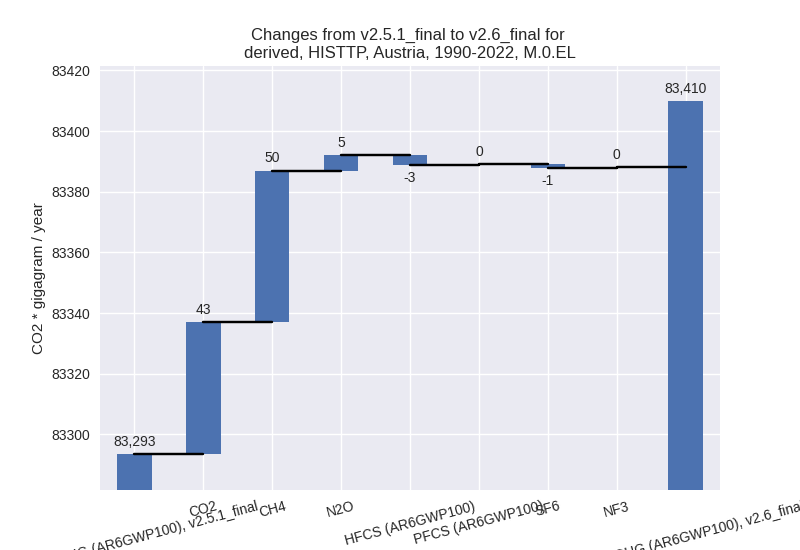
Detailed changes for the scenarios:
country reported scenario (HISTCR):
Most important changes per time frame
For 2022 the following sector-gas combinations have the highest absolute impact on national total KyotoGHG (AR6GWP100) emissions in 2022 (top 5):
- 1: 1.A, CO2 with -1154.79 Gg CO2 / year (-2.4%)
- 2: 2, CO2 with -302.30 Gg CO2 / year (-2.1%)
- 3: 2, HFCS (AR6GWP100) with -267.11 Gg CO2 / year (-13.9%)
- 4: 3.A, CH4 with 138.41 Gg CO2 / year (2.9%)
- 5: 2, SF6 with -93.03 Gg CO2 / year (-19.2%)
For 1990-2022 the following sector-gas combinations have the highest absolute impact on national total KyotoGHG (AR6GWP100) emissions in 1990-2022 (top 5):
- 1: 1.A, CO2 with -42.17 Gg CO2 / year (-0.1%)
- 2: 3.A, CH4 with 39.12 Gg CO2 / year (0.8%)
- 3: 2, HFCS (AR6GWP100) with -33.28 Gg CO2 / year (-2.6%)
- 4: M.AG.ELV, N2O with 14.40 Gg CO2 / year (0.7%)
- 5: 2, CO2 with -8.08 Gg CO2 / year (-0.1%)
Changes in the main sectors for aggregate KyotoGHG (AR6GWP100) are
- 1: Total sectoral emissions in 2022 are 48478.44 Gg
CO2 / year which is 66.2% of M.0.EL emissions. 2022 Emissions have
changed by -2.5% (-1219.13 Gg CO2 /
year). 1990-2022 Emissions have changed by -0.1% (-43.33 Gg CO2 / year). For 2022 the
changes per gas
are:
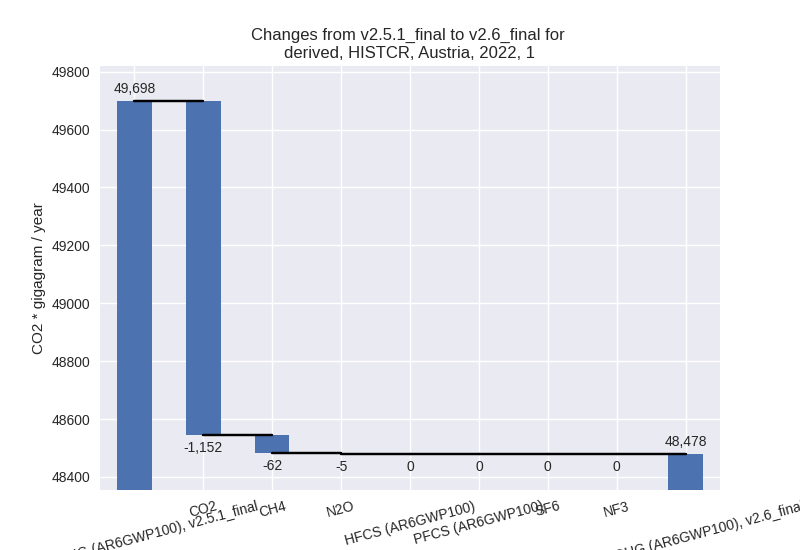
The changes come from the following subsectors:- 1.A: Total sectoral emissions in 2022 are 48168.44
Gg CO2 / year which is 99.4% of category 1 emissions. 2022 Emissions
have changed by -2.4% (-1208.01 Gg
CO2 / year). 1990-2022 Emissions have changed by -0.1% (-42.99 Gg CO2 / year). For 2022 the
changes per gas
are:
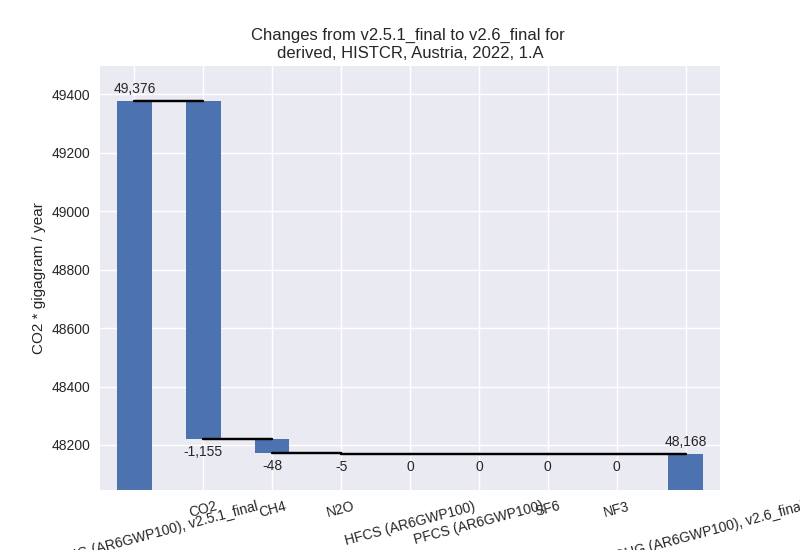
There is no subsector information available in PRIMAP-hist. - 1.B.1: Total sectoral emissions in 2022 are 0.00 Gg CO2 / year which is 0.0% of category 1 emissions. 2022 Emissions have changed by 0.0% (0.00 Gg CO2 / year). 1990-2022 Emissions have changed by 0.0% (0.00 Gg CO2 / year).
- 1.B.2: Total sectoral emissions in 2022 are 310.00
Gg CO2 / year which is 0.6% of category 1 emissions. 2022 Emissions have
changed by -3.5% (-11.12 Gg CO2 /
year). 1990-2022 Emissions have changed by -0.1% (-0.34 Gg CO2 / year). For 2022 the
changes per gas
are:
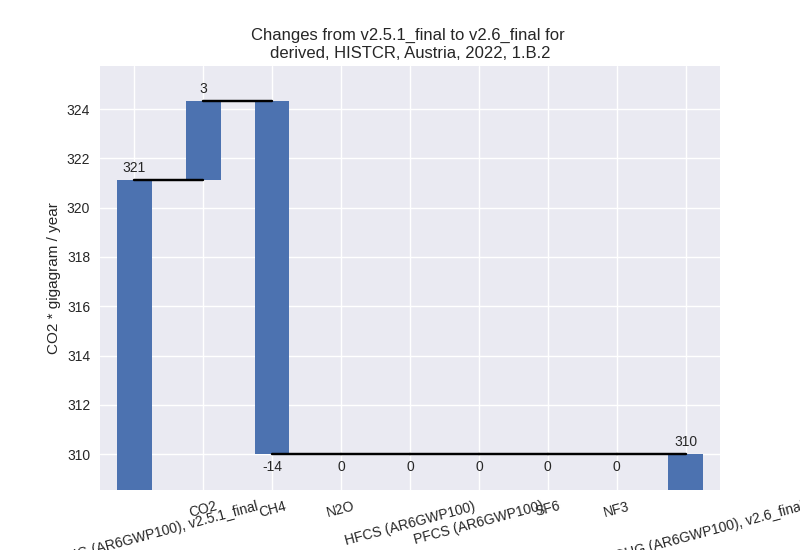
There is no subsector information available in PRIMAP-hist.
- 1.A: Total sectoral emissions in 2022 are 48168.44
Gg CO2 / year which is 99.4% of category 1 emissions. 2022 Emissions
have changed by -2.4% (-1208.01 Gg
CO2 / year). 1990-2022 Emissions have changed by -0.1% (-42.99 Gg CO2 / year). For 2022 the
changes per gas
are:
- 2: Total sectoral emissions in 2022 are 16200.45 Gg
CO2 / year which is 22.1% of M.0.EL emissions. 2022 Emissions have
changed by -3.8% (-637.63 Gg CO2 /
year). 1990-2022 Emissions have changed by -0.1% (-17.57 Gg CO2 / year). For 2022 the
changes per gas
are:
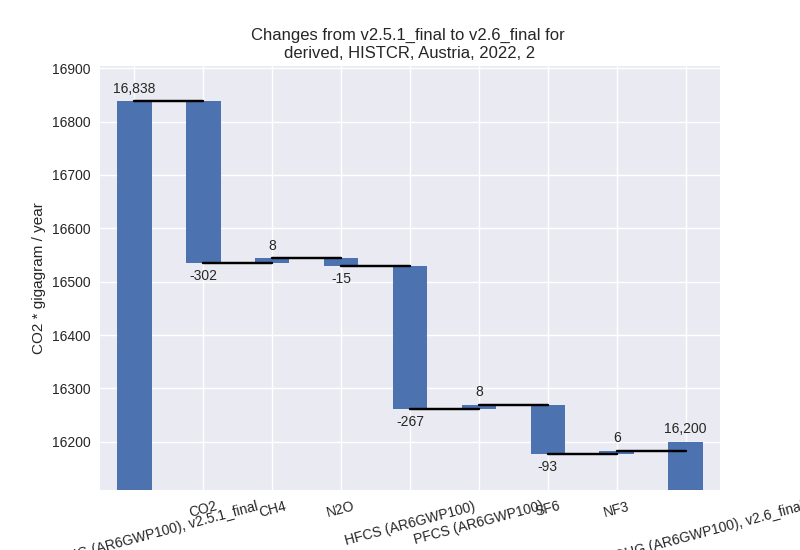
- M.AG: Total sectoral emissions in 2022 are 7326.12 Gg CO2 / year which is 10.0% of M.0.EL emissions. 2022 Emissions have changed by 1.7% (121.43 Gg CO2 / year). 1990-2022 Emissions have changed by 0.7% (54.96 Gg CO2 / year).
- 4: Total sectoral emissions in 2022 are 1177.11 Gg
CO2 / year which is 1.6% of M.0.EL emissions. 2022 Emissions have
changed by -3.1% (-37.46 Gg CO2 /
year). 1990-2022 Emissions have changed by 0.0% (0.55 Gg CO2 / year). For 2022 the
changes per gas
are:
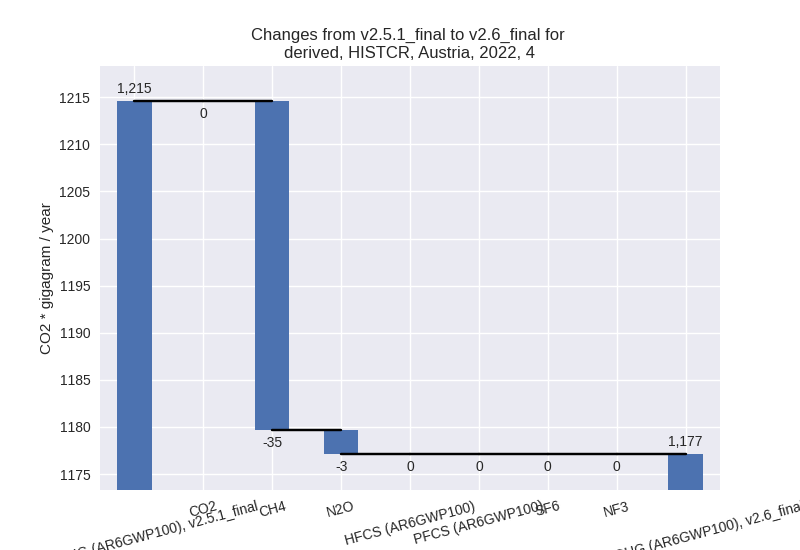
- 5: No data
third party scenario (HISTTP):
Most important changes per time frame
For 2022 the following sector-gas combinations have the highest absolute impact on national total KyotoGHG (AR6GWP100) emissions in 2022 (top 5):
- 1: 4, CH4 with 765.28 Gg CO2 / year (31.2%)
- 2: 1.A, CO2 with 635.36 Gg CO2 / year (1.2%)
- 3: 2, HFCS (AR6GWP100) with -107.19 Gg CO2 / year (-5.2%)
- 4: 2, CO2 with -57.00 Gg CO2 / year (-1.3%)
- 5: 2, SF6 with -40.35 Gg CO2 / year (-7.4%)
For 1990-2022 the following sector-gas combinations have the highest absolute impact on national total KyotoGHG (AR6GWP100) emissions in 1990-2022 (top 5):
- 1: 4, CH4 with 50.01 Gg CO2 / year (1.3%)
- 2: 1.A, CO2 with 42.68 Gg CO2 / year (0.1%)
- 3: 5, N2O with 4.91 Gg CO2 / year (1.7%)
- 4: 2, HFCS (AR6GWP100) with -3.25 Gg CO2 / year (-0.3%)
- 5: 4, CO2 with 2.49 Gg CO2 / year (268.1%)
Changes in the main sectors for aggregate KyotoGHG (AR6GWP100) are
- 1: Total sectoral emissions in 2022 are 56817.76 Gg CO2 / year which is 75.7% of M.0.EL emissions. 2022 Emissions have changed by 1.1% (635.36 Gg CO2 / year). 1990-2022 Emissions have changed by 0.1% (42.68 Gg CO2 / year).
- 2: Total sectoral emissions in 2022 are 7053.72 Gg
CO2 / year which is 9.4% of M.0.EL emissions. 2022 Emissions have
changed by -2.3% (-165.03 Gg CO2 /
year). 1990-2022 Emissions have changed by 0.2% (16.08 Gg CO2 / year). For 2022 the
changes per gas
are:
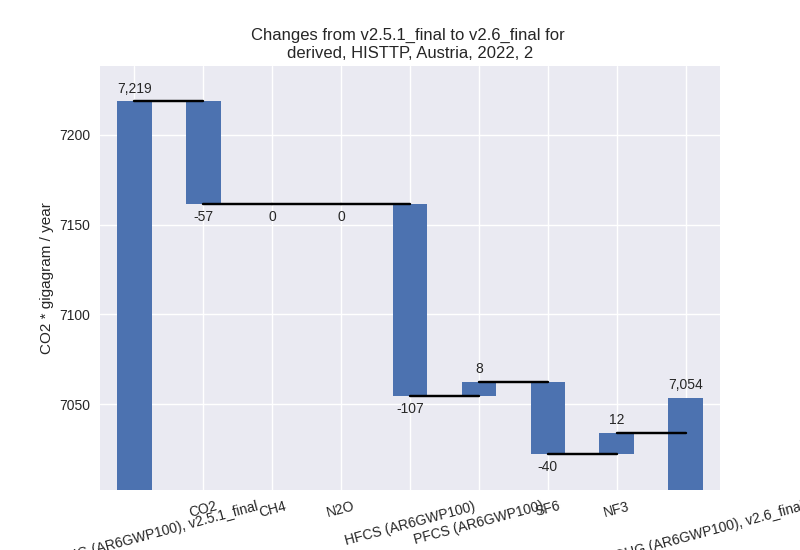
- M.AG: Total sectoral emissions in 2022 are 7532.51 Gg CO2 / year which is 10.0% of M.0.EL emissions. 2022 Emissions have changed by 0.0% (0.00 Gg CO2 / year). 1990-2022 Emissions have changed by 0.0% (0.00 Gg CO2 / year).
- 4: Total sectoral emissions in 2022 are 3493.06 Gg
CO2 / year which is 4.7% of M.0.EL emissions. 2022 Emissions have
changed by 28.0% (764.01 Gg CO2 /
year). 1990-2022 Emissions have changed by 1.2% (52.69 Gg CO2 / year). For 2022 the
changes per gas
are:
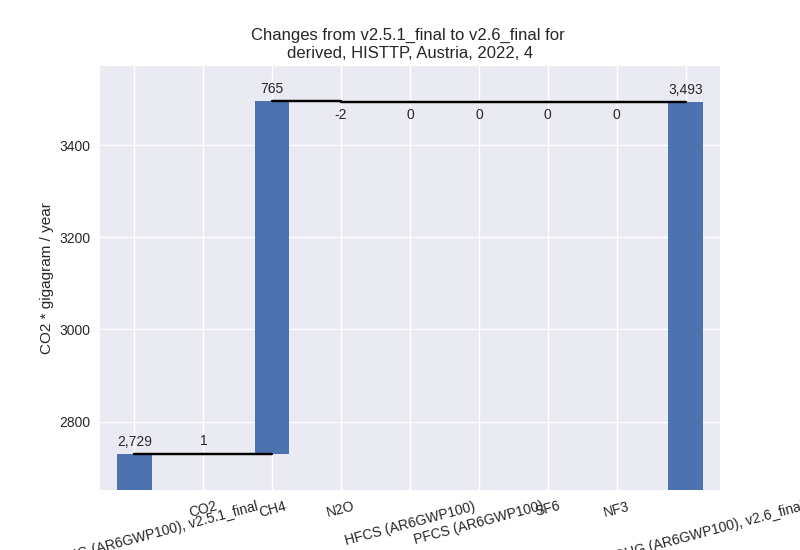
- 5: Total sectoral emissions in 2022 are 166.18 Gg
CO2 / year which is 0.2% of M.0.EL emissions. 2022 Emissions have
changed by 6.2% (9.67 Gg CO2 /
year). 1990-2022 Emissions have changed by 1.7% (4.91 Gg CO2 / year). For 2022 the
changes per gas
are:
